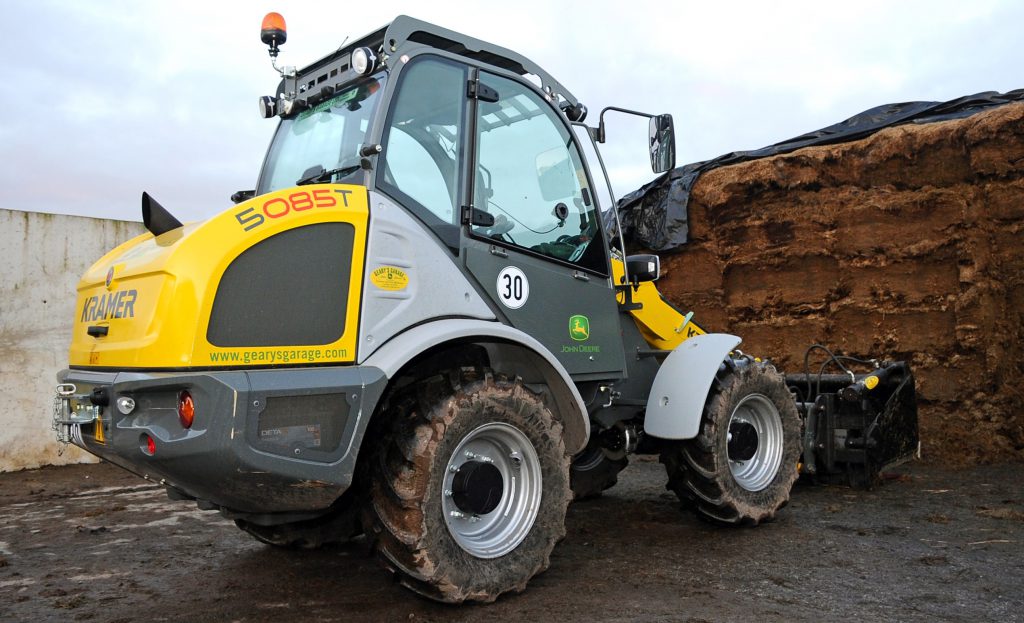John Deere has rarely, if ever, been noted for any lack of confidence in either its products or its future. It is an ethos that is carried right through to its dealers, who don’t just sell tractors but enthusiastically promote the brand wherever possible; none more so than Gearys Garage of Kilmeedy, Co Limerick.
The firm is now headed up by John Geary – great grandson of its founder, John J Geary, who sold Austin cars in between other business activities.
Tractors didn’t make an appearance until much later when his son, Brian Geary, started selling Ferguson and Steyr tractors in the 1950s. A succession of various makes then followed, before John Deere came knocking in 1979. They have stayed with the manufacturer ever since.
The loyalty has apparently paid off; Gearys Garage now employs 33 people between its two depots (the second is in Lissane, Co. Clare) and is one of the select few that sells John Deere products in Ireland.
When AgriLand called, the yard was full of new and used tractors; the workshop was clearly busy – servicing harvesters and preparing tractors for delivery.
It is shaping up to be a good year at present; that seemed to be the message from John.
Not surprisingly, he also strongly believes that the product itself plays an important role. “John Deere has a 30% share of the European tractor market,” he claimed.
The build quality and operator comfort of the 6M and 6R Series machines, in particular, are streets ahead of the competition.
When the issue of price is mentioned, he does not deny that John Deere tractors are considered expensive, saying: “They are solid tractors and are ideal for the Irish farmer.”
To counter this negative perception (of needing a friendly bank manager before turning up at the dealership), John suggests that, by deliberately “keeping the price of spare parts low”, John Deere has reduced the overall running costs of its tractors – making them a “worthwhile investment”.
In response to the question of ‘engine power density‘, John has detected a “strong aversion” to the recent trend of fitting three-cylinder engines in medium-sized tractors. “The approach whereby other companies look for more power from three or four-cylinder engines is a mistake that is of great benefit to us,” he mused.
Instead of stomping down the path of ever-increasing power density, John Deere is concentrating hard on the inclusion of digital technology into its tractors. But it doesn’t stop there; the vision is of far greater involvement in the management of both the machine and farm operations as well.
While many manufacturers will point to how IT is advancing the functionality of their products, John Deere is actively developing devices that ‘harvest’ farm management data – as eagerly as the machines harvest the crop.
To pursue this goal, the company has tapped into this expertise by opening an office in Silicon Valley. John Deere has purchased Blue River Technology, which was already active in the agricultural sphere – concentrating mainly on precision chemical application.
However, it is John Deere’s in-house team that has developed Harvest Lab 3000 – a system that is based on real-time analysis of materials such as grain, forage and slurry.
A far clearer idea of crop quality and drying requirements may also be obtained – long before samples are sent off to grain buyers. The basic unit costs around €15,000, with an additional cost (starting at €3,000) for whichever package of sensors is needed.
Thankfully, John Deere remains acutely aware of data privacy issues. It has built into its systems the ability for the customer to share with others just as much (or as little) information as they choose.
But, as John reassures us, the customer retains the option to switch such information transfer ‘off’. He firmly believes that maintaining that facility is the only way forward.
John is very much an advocate of the digital technology that is being ushered in by John Deere. From detecting potential faults in tractors to identifying costs and best practices, he considers it all part and parcel of machine optimisation.
“Farmers will be interested and certainly should be interested in this technology,” he explained.
Partnership with Kramer
He is also greatly encouraged by the partnership with Kramer, which he sees as being of tremendous benefit to both companies.
“Kramer is totally customer-focused,” he said. He went on to mention that, when a dealer delegation visited the factory, the company’s management “wanted to talk as much about what we wanted, as they did about their own product”.
“It made a refreshing change from the normal sort of trip,” he said.
Enthusiasm for the tie-up with Kramer has been bolstered by the first delivery of a loader to a local customer. Mike McCarthy milks 145 cows with his family at Feenagh, not far from Gearys’ Co. Limerick base.
He purchased a Kramer 5085T in late December; it has since become the machine of choice when it comes to feeding the farm’s herd. Mike confesses that he is still getting used to it; however, he sees its chief benefits as being “quicker and easier to use than a tractor a with front loader”.
“It’s less cumbersome and drives the block-cutter further into the silage face, without spinning its wheels,” he added.
Meanwhile, John has high hopes that the assimilation of the Kramer product line into John Deere’s distribution network will yield further advantages.
“Having the loaders on John Deere’s parts system will greatly increase their availability; it suits our technicians better to have all the information in one place.”










